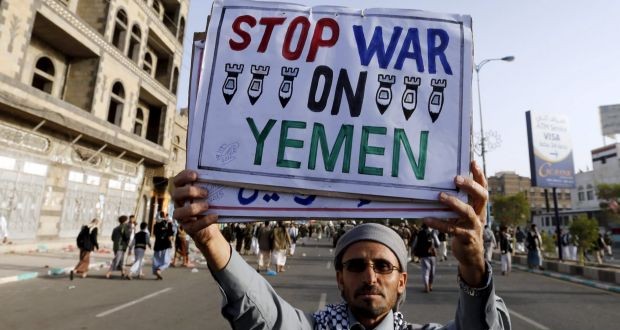PHOTO: A protester denounces Saudi-led airstrikes on Yemen, April 2015
Umer Karim of the University of Birmingham writes for EA:
The Yemen conflict is a tragedy with no end in sight. Unlike a theatrical tragedy, where the actors are unaware how their actions dictate their own doom, the actors in Yemen well know the disastrous consequences of their fights over the future of the country and its people. Fearing they will be the political losers in this jostling for power, they are grudgingly prolonging the damage and catastrophe. They are framing their political images in the misery of Yemeni people.
In early 2012, following months of protests amid the “Arab Spring”, Ali Abdullah Saleh was finally ousted from power after almost 32 years, with his deputy Abdrabuh Mansour Hadi assuming the role of country’s President. A national dialogue began among different political and regional stakeholders in Yemen, seeking to write a new constitution and agree a new form of social contract.
See also Yemen Feature: A Guide to the Civil War
During the debate over the nature of state and its power, governance under President Hadi failed to show any sign of transformation from the corrupt and authoritarian regime of Saleh. The administration failed to deliver improvement in basic civic infrastructure or to deal with the menace of Al-Qaeda. Elements within the Yemeni military were still loyal to Saleh, and the personal constituencies cultivated by him remained strong.
Meanwhile, Houthis from the Zaidi sect of Shi’ism in northern Yemen were assessing their position. Targets of military campaigns by the Saleh regime, they had supported the protests in 2011. However, the failure of the new government to address the dire political situation in the country and the assassinations of Houthi leaders forced them to abandon the national dialogue. Exercising their military strength, they took control of northern areas of Yemen and started a new political crisis.
By early 2015, the Houthis captured the capital Sana’a and moved south with assaults on the cities of Taiz and Aden, while winning the support of pro-Saleh political and military elements. Meanwhile, the Hadi Government was in disarray, with the President escaping to Aden and then to Riyadh. The prospect of Houthi ascendancy was backed by its main political supporter Iran, happy to see instability and insecurity in Saudi Arabia’s backyard.
But the Houthis overplayed their cards. The accession to power of King Salman in Saudi Arabia, with his son Mohammad as Defense Minister, launched a more aggressive Saudi policy vis-à-vis Yemen with military intervention on land and in the air from March 2015. The Saudi-led coalition pushed the Houthis back in southern and eastern Yemen, ending any chance of diplomatic or political engagement with the Houthis or Saleh to resolve the crisis.
Framing Yemen as an arena for regional influence could be a mistake by the Saudis and their allies. The military campaign might have been more effective if it was established as a response to the aggressive diplomatic and political posturing of the Houthis. The intense bombing of northern Yemen, with the killing of thousands of civilians, exacerbated humanitarian disaster in Yemen, even if siege and shelling by Houthis of areas such as the city of Taiz, contributed to the misery.
Meanwhile, Al Qa’eda in the Arabian Peninsula capitalized on this power struggle, especially in the eastern region of Hadhramaut, embedding itself within local structures of governance for provision of basic needs to the people. The approach helped it not only to erase the exclusive and outsider image of group in Yemeni politics but also to get it into governance bodies and structures that could generate revenues for the organization. Belatedly the Hadi-supporting coalition forces expelled AQAP from the port city of Mukalla, depriving it of millions of dollars per day in oil revenue.
A plethora of forces is grouped under the banner of President Hadi’s government to fight the Houthis. They range from southern secessionists to Islah Party and its Hashid tribal allies who are arch-rivals of Ali Abdullah Saleh. The Saudis are close to Islah and more amenable to talk to the Houthis rather than former President Saleh. UAE, the other major coalition partner, is sceptical of Islah due to its Muslim Brotherhood leanings and softer towards Saleh; it also has historical links with southern forces. Given that all of today’s allies — on both sides of the political divide — have fought with each other, any shift in the political calculus could shift these allies into foes.
The latest development, in which the coalition forces have started an offensive to secure coastal cities along the Bab-e-Mandab Strait, spells a long war. With the war now revolving around the personality of the Saudi King’s son, Deputy Crown Prince and Defence Minister Muhammad Bin Salman, Riyadh cannot afford a solution that undermines their political prestige: Saudi acceptance of a Houthi hold over Sana’a would be catastrophic for his position. With the Saudi economy showing signs of improvement and oil prices recovering, one can expect Riyadh and its allies to bankroll the war even further.
The Houthis are under pressure, with their siege of some areas and action against political opponents damaging hopes of a state-building project under their leadership. The effects of a Saudi-led naval and land blockade are weighing on their differences with Saleh and could lead to anarchy with their alliance. Southerners may think they have time for their cause of independence, but as long as South Yemen acts as the base camp for the military campaign against the North, it will be difficult to fulfil the dream. The political future of eastern Yemen is also far from clear.
There can be no all-out victory for anyone in Yemen: a resolution can only occur if all parties back away from their maximalist positions. But for now, the recognition of the necessity of power-sharing is still far off.

